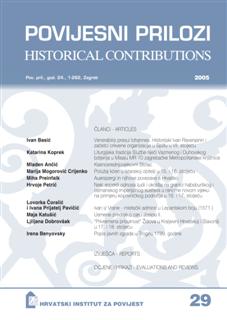Položaj kćeri u istarskoj obitelji u 15. i 16. stoljeću
The position of the daughter in Istrian family in the 15th and 16th centuries
Author(s): Marija Mogorović CrljenkoSubject(s): History
Published by: Hrvatski institut za povijest
Keywords: Istria; Istrian statutes; the position of daughters; inheritance; endowment; marriage; custody
Summary/Abstract: Based on the Istrian statutes, court files of the Novigrad office (1492-1600) and books of Martin Sotolić, a notary from Buzet (1492-1517) this work shows the position of the daughter in Istrian family in the 15th and 16th centuries. Even though the position and the role of female children in the family cannot be established beyond dispute, it can be at least somewhat clarified with the help of the mentioned sources. Special attention is given to the questions of inheritance, custody, relations with parents and siblings, marrying age and the choice of a spouse In Istria, children received their paternal inheritance with no preferential treatment of male children. This situation was, in a large degree, different from the one in certain Dalmatian towns where sons were favored in inheriting the family assets. Yet, even in Istria, there were cases of parents’ testamentary preference for a particular child, regardless of sex. Therefore, the children were not always equal when it came to inheritance. While assigning custody, daughters were put on equality with sons. In general, custody was assigned to the surviving parent. Yet, in the case of the mother’s remarrying, the custody was assigned to the paternal relatives. It was proscribed that the inventory of the children’s assets be made so that they would not be deprived of their inheritance in the process of assigning custody. Individual testaments and deeds of gift confirm that the relations between siblings were harmonious and that they took care of each other through endowments. It is also evident that parents often showed preference for particular children by amply endowing them. Usually, mothers would endow daughters and fathers their sons even though this was not a rule. However, there were cases where relations between parents and children were disrupted by disagreements and disputes over distribution of assets in which brothers and sisters took the opposing sides. The Istrian statutes proscribed the age between 12 and 14 for girls and 14 to 15 for boys as the age of majority. However, the children generally did not marry this young. According to the available resources and comparative data for the later period in Istria and neighboring areas (Dalmatia and Italy), it seems that girls married around the age of 20. Young men, on the other hand, married around the age of 25, when they were old enough to support a family. Parents, that is, relatives or guardians had a decisive role in choosing a spouse, especially for girls. However, there were situations where the bride and groom opposed their parents’ choice and, mostly by arranged kidnappings, chose their future partner themselves, even at the price of disinheritance.
Journal: Povijesni prilozi
- Issue Year: 2005
- Issue No: 29
- Page Range: 59-77
- Page Count: 19
- Language: Croatian

